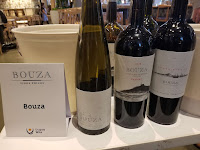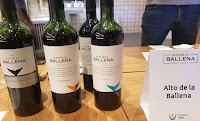Uruguay resides in the same parallels as its neighbors Argentina & Chile, but also South Africa, Australia, and New Zealand. The soils are mostly clay, there's plenty of sunshine, and the vineyards are primarily situated near the Rios de la Plata (across from Buenos Aires) or near the Atlantic Ocean. Think cool coastal breezes and balanced and structured wines. There's a relatively long wine-making tradition in the county as immigrants from Spain, Italy, and Germany brought their wine-making traditions and wine grapes with them.
It's most important to stress the maritime influences upon viticulture. According to our prep material, "About a third of Uruguay has an Atlantic coastline. The dominant winds in Uruguay come from the sea, bringing with them cool, rainy conditions resulting in about 1,000 mm/39 inches of rainfall a year, while the interior experiences high peaks in temperature in summer and rainfall that can be as much as 63 inches/1600 mm a year in some areas.Uruguay is located on the Río de La Plata craton; a craton is a mass of pre-Cambrian rock that has not been affected by the movement of continents. The Río de la Plata craton is one of five on the continent of South America. The craton and rivers help create three distinct soil types. "(1) In the Department of Maldonado it takes the form of low, heavily eroded sierras of grey granite – 2.5 billion years old, and the oldest rock on the planet. The soils of Maldonado are formed by the erosion of this rock and are rich in clay, with varying depth determined by proximity to the hills. (2) Around Montevideo, in Canelones, the soils are deeper, created by erosion of the craton itself as well as eolian deposits. These soils are clay-based and retain less water, depending on the sand content brought by the river. (3) The shore of the Uruguay River, between San José and Colonia, has clay soils deposited by the river along with abundant pockets of calcium carbonate created by dead sea life from previous eras.
Wine Regions:
- Metropolitan: 12,076 acres/4,887 ha
Includes departments of San José, Canelones, and Montevideo. Deep, clay soils also include strips of pink granite, making for a terroir well-suited to Tannat. - Oceanic: 1,053 acres/426 ha
Includes two departments, Maldonado and Rocha with a varied topography which is the primary factor in distinguishing its wines. The Cuchilla Grande is the highest point in Uruguay, reaching a height of 1,600 feet/488 m above sea level, contributing a mix of granite and ballast to the soils. The climate is oceanic where white varieties dominate. - Southern Riverside: 722 acres / 292 ha
Includes departments of Colonia, Río Negro, and Soriano. The influence of the Uruguay River can be seen in the sedimentary soils of Carmelo, while the San Juan River is distinguished by rockier soils. The region accounts for 5.2% of hectares under vine in Uruguay. Carmelo lies at the center of the southern shore. A dozen wineries are scattered throughout the area. Soils are distinguished by pockets of calcium carbonate deposits. Reds are the heart of the region. - Northern Riverside: 408 acres/165 ha
This terroir spans the departments of Artigas, Paysandú and Salto along the shore of the Uruguay River. This is a continental terroir, with a thermal range between day and night of up to 20 degrees, and high relative humidity. Soils range from riverbed gravel to calcareous clay, with varying amounts of lime and sand. - Center: 109 acres/44 ha
Here, the departments of Durazno, Florida, and Lavalleja are the most relevant in terms of area under vine. The soil and climate are similar to that of the Metropolitan area. - North: 84 aces/34 ha
The Rivera and Tacuarembó departments are planted in different geological formations, each rich in iron, comprising 84 acres/34 ha of vines, or 0.6% of the total. A continental climate with a significant thermal range. Experiences more hours of sunlight than any other region of Uruguay.
The Wines:
Pisano Wines is witness to a century of winemaking tradition - in Progreso in Canelones - and is operated by three Pisano brothers: Gustavo, the winemaker; Eduardo, the agronomist; and Daniel, the export manager. The family traces their heritage to Italian and Basque immigrants - this later from the group of people who introduced Tannat to Uruguay. Again like Montes Toscanini, the Pisano wines benefit from the Río de la Plata (River Plate) - an estuary formed by the confluence of the Uruguay River and the Paraná River at Punta Gorda. The Pisano RPF Tannat 2020 Progreso, Canelones ($24) s a fresh and well-rounded wine with light and chewy sour cherries that alternate with darker fruit and soft tannins.
The Cerro del Toro Winery was started by the Norwegian businessman, Lars T Ugland and the Kambara family from Japan in 2016 in a joint venture. The winery is located on the north-eastern face of the Cerro del Toro hill in an 800-hectare estate in Piriápolis. The Cerro del Toro vineyard currently have 28 hectares of vines planted only 2 km from the Atlantic Ocean. The Cerro del Toro Tannat 2020 Piriápolis, Maldonado ($25)vis unoaked with the dark fruit coming forward with some earthiness and saline as the freshness lasts long into the tail.
Bodega Garzón is also a coastal winery located eleven miles from the Atlantic Ocean. Their estate has more than 1,000 small vineyard blocks covering its hillside slopes, which benefit from varying microclimates, different levels of humidity, and an intense canopy management as was described above. These factors allow the vines to develop with maximum exposure to the sun providing rich, expressive fruit. This is the Garzón Reserva Tannat 2021 Maldonado ($18) in a nutshell, very structured with layers of fresh fruit and an extended finish.
Alto de la Ballena is a small winery operating in the Sierra de la Ballena located just 15 kilometers from the Atlantic coast. The small 8-hectare estate vineyard benefits from the oceanic air as well as excellent drainage from the steep, granite, and schist hillside mountain soils. The winery's birth is dated at the Millenium when Paula and Alvaro quit their finance jobs after spending the previous two years searching for the ideal vineyard location. They found that in the Maldonado department in the Oceanic region. They showed an interesting wine in the Alto de la Ballena Tannat Viognier 2018 Sierra De La Ballena ($26) - an 85-15% blend. They manage both lots so that they can be harvested very close together allowing for co-fermentation. The Viognier adds a more intense aroma and softens the Tannat's tannins creating a fantastic fresh wine. Still structured with juice acidity, some herbs, and juice and chewy sour cherries.
Basta Spirit was founded in 2018 and produces spirits using a Tannat base. The Vermut Flores Rosé NV Canelones ($16) contains 27 botanicals, including flowers such as hops, chamomile, rose, and elderberry. It is extremely aromatic, with loads of herbaceousness and forest spiciness - very gin-like. One participant mentioned sipping with sour cherry juice and thus I created a delicious using equal parts vermouth and Del Maguey Mezcal followed by a heavy dose of Don Ciccio & Figli Cerasum Aperitivo.












